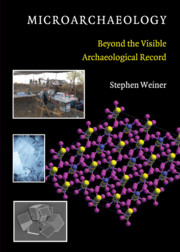Book contents
- Frontmatter
- Contents
- Preface
- 1 Archaeology, Archaeological Science, and Microarchaeology
- 2 Information Embedded in the Microscopic Record
- 3 Completeness of the Archaeological Record
- 4 Common Mineral Components of the Archaeological Record
- 5 Biological Materials: Bones and Teeth
- 6 Biological Materials: Phytoliths, Diatoms, Eggshells, Otoliths, and Mollusk Shells
- 7 Reconstructing Pyrotechnological Processes
- 8 Biological Molecules and Macromolecules: Protected Niches
- 9 Ethnoarchaeology of the Microscopic Record: Learning from the Present
- 10 Absolute Dating: Assessing the Quality of a Date
- 11 Reading the Microscopic Record On-Site
- 12 Infrared Spectroscopy in Archaeology
- Appendix A Identifying Minerals Using Microchemical Analysis
- Appendix B Identifying Minerals and Compounds Using Infrared Spectra: Table of Standard Minerals and Compounds for Which Infrared Spectra Are Available
- References
- Index
- Plates section
8 - Biological Molecules and Macromolecules: Protected Niches
Published online by Cambridge University Press: 05 June 2012
- Frontmatter
- Contents
- Preface
- 1 Archaeology, Archaeological Science, and Microarchaeology
- 2 Information Embedded in the Microscopic Record
- 3 Completeness of the Archaeological Record
- 4 Common Mineral Components of the Archaeological Record
- 5 Biological Materials: Bones and Teeth
- 6 Biological Materials: Phytoliths, Diatoms, Eggshells, Otoliths, and Mollusk Shells
- 7 Reconstructing Pyrotechnological Processes
- 8 Biological Molecules and Macromolecules: Protected Niches
- 9 Ethnoarchaeology of the Microscopic Record: Learning from the Present
- 10 Absolute Dating: Assessing the Quality of a Date
- 11 Reading the Microscopic Record On-Site
- 12 Infrared Spectroscopy in Archaeology
- Appendix A Identifying Minerals Using Microchemical Analysis
- Appendix B Identifying Minerals and Compounds Using Infrared Spectra: Table of Standard Minerals and Compounds for Which Infrared Spectra Are Available
- References
- Index
- Plates section
Summary
Some of the most interesting questions about past human behavior can, in theory, be addressed by analyzing preserved biologically produced molecules. These biogenic molecules may contain information on absolute age based on their radiocarbon contents, genetic development using ancient DNA, migration patterns, weaning and diet using stable isotopes, and more (Chapter 2). In most environments, biological macromolecules are, however, not preserved, as exposed uncharred organic matter is efficiently and rapidly degraded, mainly by microorganisms. There are special environments, such as in frozen ice and very dry deserts, where organic materials are relatively well preserved, mainly because of the lack of biological activity (Chapter 3). Much can be learned about past human behavior from biomolecules preserved under these unusual conditions. Using only these “exotic” sources of materials, however, makes it very difficult to apply a systematic and regional approach to solving problems using biogenic molecules. For such systematic studies, we ideally need to be able to analyze biological molecules from many sites and/or many locations within a site, even when most of the organic matter has been degraded.
The only way biological molecules can survive biodegradation and chemical degradation under “normal” conditions is if they are located in protected niches that prevent microbial degradation or chemical breakdown. Some protected niches are known. Characterizing these niches is the focus of this chapter.
- Type
- Chapter
- Information
- MicroarchaeologyBeyond the Visible Archaeological Record, pp. 207 - 226Publisher: Cambridge University PressPrint publication year: 2010



